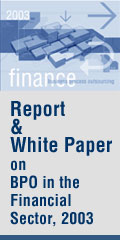|
|
RBI Policy impact - Short-term costs but medium-term benefits
July 29, 2008 — Although the increase in the repo rate by 50 bps was unexpected, the
firmness of its anti-inflationary stance sends a strong signal to the markets that the Reserve Bank of
India (RBI) sees spiralling inflation as a far greater threat than slowing growth. Coming soon after a
similar move last month, Tuesday's announcement leaves no one in any doubt about the central
bank's determination to bring the rate of inflation down as quickly as possible. While the measures will
have an adverse impact on demand through higher interest rates, which are bound to increase, given
the tight liquidity conditions, the threat that rising inflationary expectations poses to medium-term
growth performance is real and justifies the aggressive anti-inflationary stance taken by the RBI, even
if it comes at some cost in the form of slower growth in the immediate future.
Dr. Subir Gokarn, Chief Economist, Standard & Poor's Asia Pacific, said: "We have to accept the
fact that a trade-off between growth and inflation in the current circumstances is inevitable. Despite
the clear signs that growth is slowing, as seen in the recent industrial production numbers, it is far too
early for the Reserve Bank of India to move to a neutral position, let alone reverse course. Even after
all that has been done, inflationary pressures may still be aggravated by global developments but, for
the moment, the current policy stance is the most appropriate one."
Mr. Dharmakirti Joshi, Principal Economist, CRISIL, added: "The decision to raise the repo rate by
50 bps rather than the much-anticipated 25 bps was motivated by two factors. One, the fiscal
situation, particularly on account of the loan waiver and the implementation of Pay Commission
recommendations, is providing a demand stimulus, which can only intensify the inflationary pressure.
Two, since domestic fuel prices do not fully reflect the global price scenario, energy prices are not
helping to reduce demand to the fullest possible extent. This also adds to demand-side inflationary
pressures."
With high inflation rates likely to persist over the next few months, we do expect further tightening in
or before the next scheduled announcement at the end of October. Our current outlook for key
macroeconomic indicators for 2008-09 are as follows: GDP growth at 7.8 per cent; average wholesale
inflation for the year at 11.5-12 per cent, although this will fall sharply in March 2009; year-end yield
on 10-year government securities in the range of 8.8-9 per cent; and, the year-end rupee-dollar
exchange rate at Rs.41.5-42/$. The policy stance will clearly have a negative bearing on the growth
outlook for 2009-10, but this is an expected part of the adjustment process, which will help to
preserve a favourable medium-term trend.
(This is press release of Crisil)
Full Text of First Quarter Review of RBI's Annual Policy Statement 2008-09
Highlights of First Quarter Review of its Annual Policy Statement 2007-08
Macroeconomic and Monetary Developments: First Quarter 2008-09
CLICK FOR RBI CREDIT POLICIES
CLICK FOR MORE FEATURES & STORIES

|
|


|



